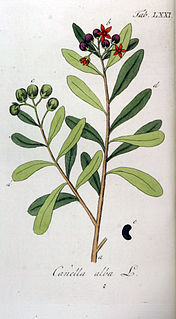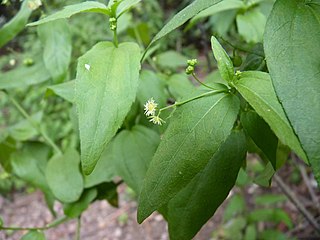| Cinnamodendron | |
|---|---|
| Scientific classification | |
| Kingdom: | Plantae |
| Clade: | Angiosperms |
| Clade: | Magnoliids |
| Order: | Canellales |
| Family: | Canellaceae |
| Genus: | Cinnamodendron Endl. |
| Synonyms [1] | |
CapsicodendronHoehne | |
Cinnamodendron is a genus of plants in family Canellaceae described as a genus in 1840. [2] [3]

Plants are mainly multicellular, predominantly photosynthetic eukaryotes of the kingdom Plantae. Historically, plants were treated as one of two kingdoms including all living things that were not animals, and all algae and fungi were treated as plants. However, all current definitions of Plantae exclude the fungi and some algae, as well as the prokaryotes. By one definition, plants form the clade Viridiplantae, a group that includes the flowering plants, conifers and other gymnosperms, ferns and their allies, hornworts, liverworts, mosses and the green algae, but excludes the red and brown algae.

The Canellaceae are a family of flowering plants in the order Canellales. The order includes only one other family, the Winteraceae. Canellaceae is native to the Afrotropic and Neotropic ecozones. They are small to medium trees, rarely shrubs, evergreen and aromatic. The flowers and fruit are often red.
Cinnamodendron is native to South America and the West Indies. [1]

South America is a continent in the Western Hemisphere, mostly in the Southern Hemisphere, with a relatively small portion in the Northern Hemisphere. It may also be considered a subcontinent of the Americas, which is how it is viewed in the Spanish and Portuguese-speaking regions of the Americas. The reference to South America instead of other regions has increased in the last decades due to changing geopolitical dynamics.

The West Indies is a region of the North Atlantic Ocean in the Caribbean that includes the island countries and surrounding waters of three major archipelagos: the Greater Antilles, the Lesser Antilles and the Lucayan Archipelago.
- Species [1]
- Cinnamodendron angustifolium - Massif de la Hotte
- Cinnamodendron axillare - Rio de Janeiro
- Cinnamodendron corticosum - Jamaica
- Cinnamodendron cubense - Cuba
- Cinnamodendron dinisii - S Brazil
- Cinnamodendron ekmanii - Dominican Rep
- Cinnamodendron occhionianum - São Paulo
- Cinnamodendron sampaioanum - Rio de Janeiro
- Cinnamodendron tenuifolium - Suriname
- Cinnamodendron venezuelense - Monagas





